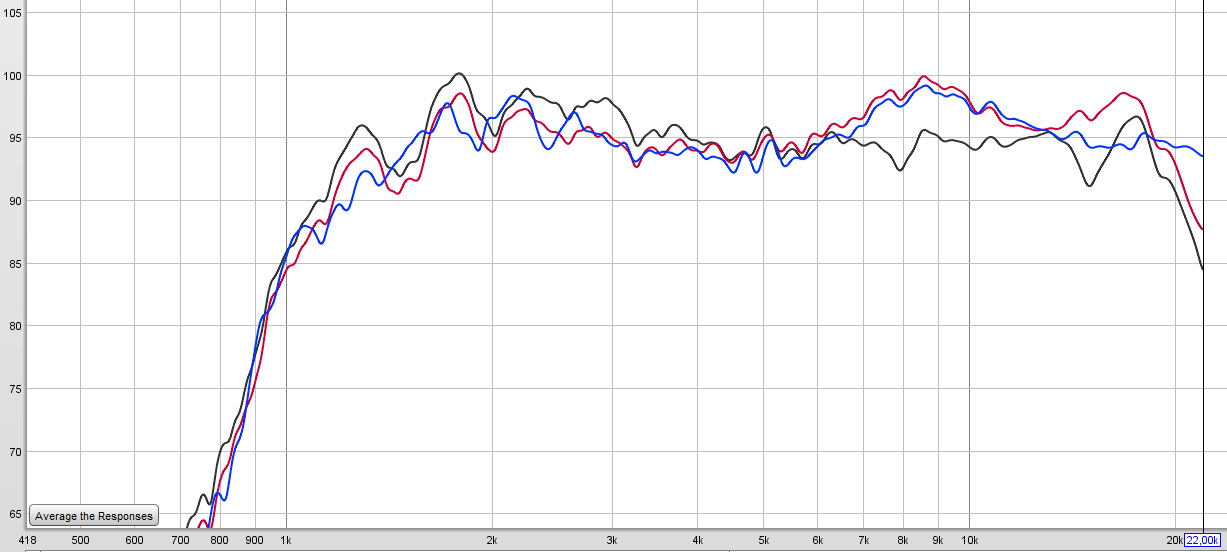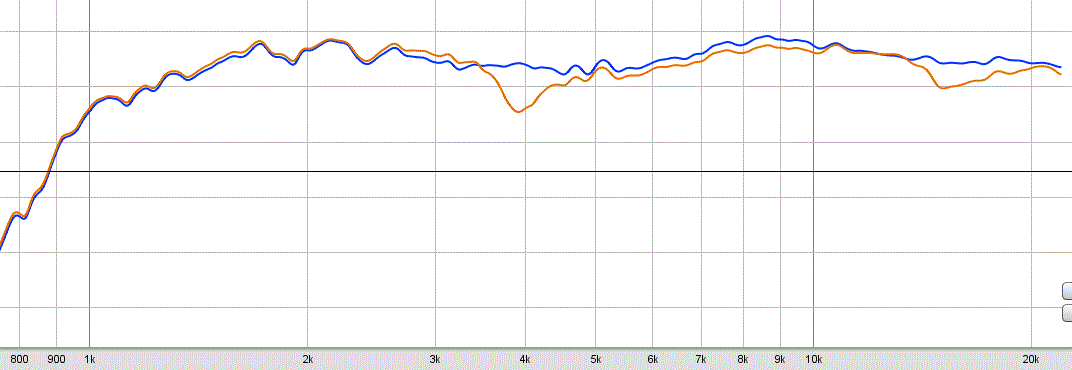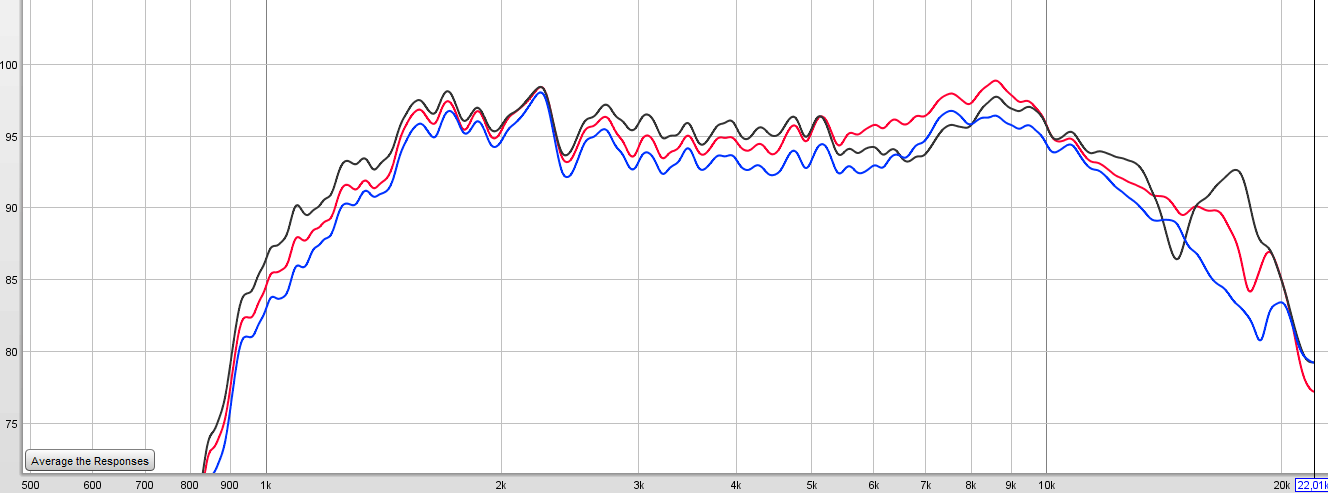Now that the tweeters work perfect, it's time for some more measurements.
I'm doing them in free air and with no speaker enclosure on the sides, with no back chamber and no factory glued felt pad on the back, since those are bad for the sound quality as many people have noticed. Instead, I put some loose absorbing material there, which sucks the back wave so it does not mess the measurement.
The mic distance is 1 meter, straight from the front. LR 48db 800 hz high pass active crossover filter is on. I've put the volume a little bit above the normal listening level, but not very loud either. I didn't calibrate the spl, so don't pay too much attention to those numbers.
I won't do any measurements with the original tpl horn, because it's way too directive for my taste and after the modifications it is not compatible with the new, wider shape anyway.
First, the frequency response comparison of the unmodified TPL 150 with standard flat front plate (black)
My own heavily modified version shown in the previous posts without the front plate (blue)
Unmodified TPL 150 also naked without the front plate (red)

My version seems to have quite an advantage above 14 khz with more straight response and better extension to 22 khz too, just like we noticed previously with the horn on close range.
On the other hand, running without the front plate creates a big bump between 7 and 10 khz.
However, in my listening test, even the stock tweeter seems to sound better without the front plate. The mouth of the plate is more narrow than the tweeter output slots width, so that is not surprising. Removing the front plate and EQuing the response flat is something that brings the best results when sound quality is concerned, in my opinion. One good option is to just widen and angle the front plate hole outwards instead of the factory inwards, then you can still use it normally for mounting the driver and yet have no colorization from it.
I'm doing them in free air and with no speaker enclosure on the sides, with no back chamber and no factory glued felt pad on the back, since those are bad for the sound quality as many people have noticed. Instead, I put some loose absorbing material there, which sucks the back wave so it does not mess the measurement.
The mic distance is 1 meter, straight from the front. LR 48db 800 hz high pass active crossover filter is on. I've put the volume a little bit above the normal listening level, but not very loud either. I didn't calibrate the spl, so don't pay too much attention to those numbers.
I won't do any measurements with the original tpl horn, because it's way too directive for my taste and after the modifications it is not compatible with the new, wider shape anyway.
First, the frequency response comparison of the unmodified TPL 150 with standard flat front plate (black)
My own heavily modified version shown in the previous posts without the front plate (blue)
Unmodified TPL 150 also naked without the front plate (red)

My version seems to have quite an advantage above 14 khz with more straight response and better extension to 22 khz too, just like we noticed previously with the horn on close range.
On the other hand, running without the front plate creates a big bump between 7 and 10 khz.
However, in my listening test, even the stock tweeter seems to sound better without the front plate. The mouth of the plate is more narrow than the tweeter output slots width, so that is not surprising. Removing the front plate and EQuing the response flat is something that brings the best results when sound quality is concerned, in my opinion. One good option is to just widen and angle the front plate hole outwards instead of the factory inwards, then you can still use it normally for mounting the driver and yet have no colorization from it.
So what about the modified driver with the stock front plate? I didn't want to clutter the previous chart, so for giggles here it is. As you notice there are some complications already. Orange is with the plate.

Next measurement horizontal plane, 25 degrees off-axis, still from 1 meter.
Blue is the modified Beyma without front plate, black unmodified with front plate, red unmodified without the front plate.

The front plate seems to cause havoc above 13 khz, response goes down at 15 k and then bounces up near 18 k.
The modified seems slightly more directional which is great, since when I got the tweeter some years ago I thought it was too wide. Then again with horn, it was too directional.
However now my living room is different and I can use a bit more wide horizontal dispersion so this is now pretty spot on. I also measured in the vertical plane at 10 degree off axis, but there was no improvement on that. On that axis, I would have liked less directional, but it was exactly the same.

Next measurement horizontal plane, 25 degrees off-axis, still from 1 meter.
Blue is the modified Beyma without front plate, black unmodified with front plate, red unmodified without the front plate.

The front plate seems to cause havoc above 13 khz, response goes down at 15 k and then bounces up near 18 k.
The modified seems slightly more directional which is great, since when I got the tweeter some years ago I thought it was too wide. Then again with horn, it was too directional.
However now my living room is different and I can use a bit more wide horizontal dispersion so this is now pretty spot on. I also measured in the vertical plane at 10 degree off axis, but there was no improvement on that. On that axis, I would have liked less directional, but it was exactly the same.
Last edited:
Made a typo on the previous post, wanted to say: 20 degree off axis in the vertical plane and not 10.
I would also like to point out that I use the same membrane on all the measurements, only the metal-magnetic structure/front plate is changed. That way there are less variables since no membrane is 100% identical.
Now some distortion measurements from 1 meter distance. As you can see, the front plate increases it. It also seems drilling the holes and grinding some metal off reduces it little bit on the modified version too.
link to the animation
I made a link since I could not get an animated picture gif to move in the text area?
I would also like to point out that I use the same membrane on all the measurements, only the metal-magnetic structure/front plate is changed. That way there are less variables since no membrane is 100% identical.
Now some distortion measurements from 1 meter distance. As you can see, the front plate increases it. It also seems drilling the holes and grinding some metal off reduces it little bit on the modified version too.
link to the animation
I made a link since I could not get an animated picture gif to move in the text area?
Last edited: